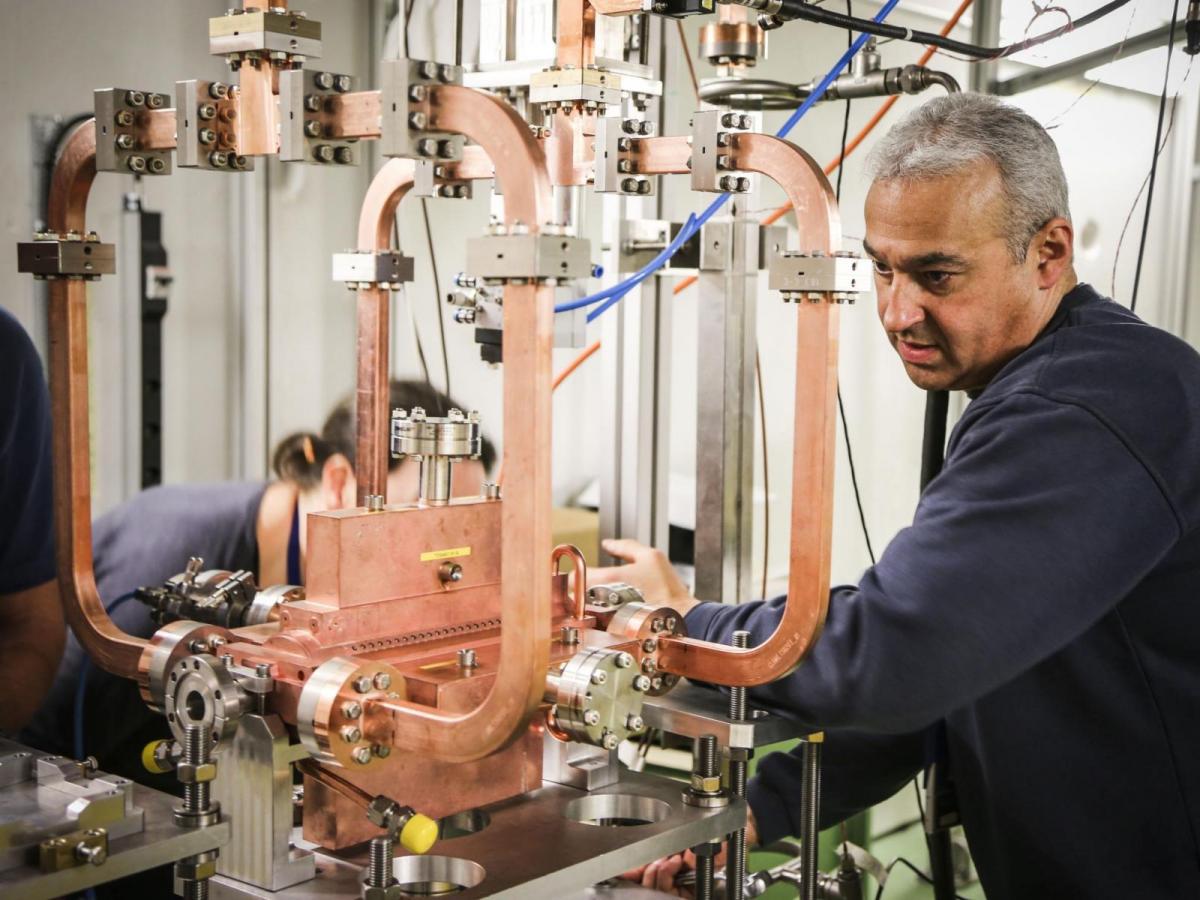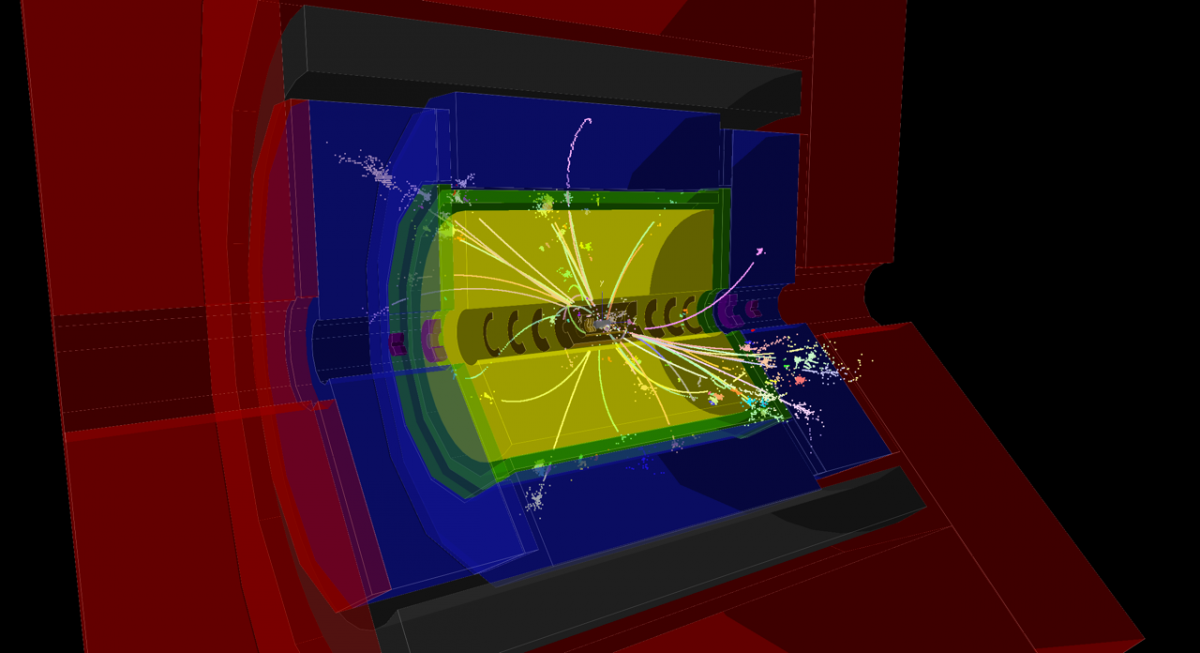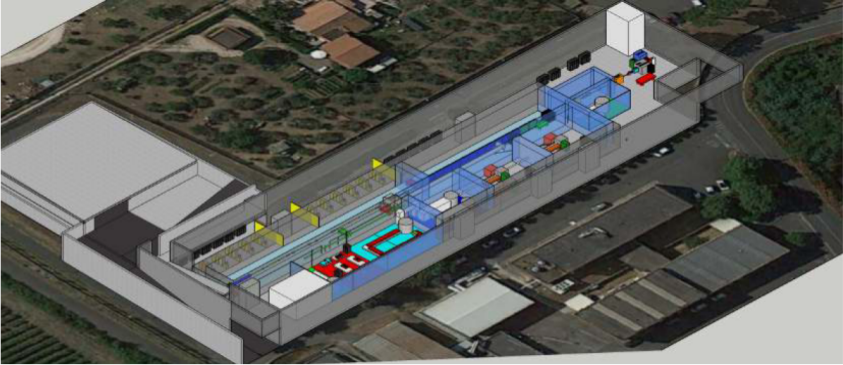CLIC is ready to be built

A damped accelerating structure prototype for CLIC being installed at the XBOX3 facility at CERN

The high-gradient X-band test facility at CERN
|
- CLIC baseline – a drive-beam based machine with an initial stage at 380 GeV
- The CTF3 (CLIC Test Facility at CERN) programme addressed all drive-beam production issues
- Accelerating gradient at ~100 MV/m demonstrated in numerous prototypes
- Other critical technical systems (alignment, damping rings, beam delivery, etc.) addressed via design and/or test-facility demonstrations
- A klystron-based CLIC machine is also an option for 380 GeV – hardware demonstrated in accelerating-structure test stands
- Two C-band XFELS (SACLA and SwissFEL) now operational: large-scale demonstrations of normal-conducting, high-frequency, low-emittance linacs
|
CLIC at 380 GeV
- CLIC high gradient technology allows for a compact accelerator
- 11 km total length ~LHC diameter, interaction region on CERN premises
- Proposed site geology well understood and extremely stable
- High luminosity: 1.5x1034 cm-2 s-1
- The CLIC design attempts to minimise use of power and cost
- Ongoing technical studies (accelerating structures, RF system, magnets, ...) will allow further reduction of power and cost while maintaining overall performance
|

The footprint of CLIC at 380 GeV incl. drive and main beam complex
|
Excellent coverage of the Standard Model

A simulated top-quark pair at 380 GeV
|
- The physics programme of CLIC at 380 GeV provides excellent coverage of the Standard Model of particle physics
- The centre-of-mass energy of the first CLIC stage was recently changed to 380 GeV to maximise the potential for precision measurements of both the Higgs boson and the top quark:
- Two different Higgs boson production modes: our overall knowledge of the Higgs boson is enhanced by measuring Higgsstrahlung and WW-boson fusion processes together
- A large number of top quark pairs are produced at the same time; these have never previously been studied in electron-positron collisions
- The Higgs and top quark coupling strengths to the other Standard Model particles can be determined with very high precision – sensitive to a wide range of phenomena beyond the Standard Model
- Beyond Higgs and top physics, CLIC allows to perform many other precision measurements at 380 GeV, with expected precisions far exceeding the LEP results
|
CLIC could be expanded to above 3 TeV with novel technologies
- 100 MV/m can be achieved with CLIC X-band technology – with this technique a centre-of-mass energy of 3 TeV can be reached
- Novel accelerating technology, including plasma wakefield and dielectric accelerators, have recently demonstrated accelerating gradients largely exceeding 100 MV/m
- The CLIC project studies whether novel technologies could be used to expand the energy range of a CLIC machine to reach collisions at 10 TeV or higher
|

Image credit: W. An/UCLA 2015
|
CLIC power consumption

Estimated power consumption of CLIC in MW at 380 GeV (total: 252 MW)

Estimated yearly energy consumption of CLIC
|
- Power and energy consumption at 380 GeV is well within the existing parameters and installations at CERN
- Substantial development work is focused on:
- improving efficiency of the RF systems (high efficiency klystrons and modulators)
- reducing magnet power (e.g. by using permanent magnets)
- minimising overheads for auxiliary systems
- At 1.5 TeV the energy consumption will surpass the current CERN usage (2017) by ~30%
- Normal conducting – significant potential for reduced energy costs by operation in off peak periods
- At 3 TeV the energy consumption will be a factor two of the current CERN usage (2017).
- Beyond the on-going studies mentioned above, further reduction might be needed at the 1.5 and 3 TeV stages (e.g. by reducing yearly operation from 8 to 6 months)
|
CLIC high-gradient applications
- Inspired by the progress made in CLIC high-gradient technology, a growing number of projects are planning to use high-gradient and/or X-band technology:
- Compact linacs and advanced diagnostics for photon sources (XFEL and Compton)
- Medical applications (proton acceleration and very high energy electron therapy)
- Linacs to test advanced acceleration technique
- Motivations include:
- higher performance (energy, repetition rate)
- lower cost (length, stored energy, efficiency)
- integration (energy upgrades to existing linacs)
|

INFN Frascati advanced acceleration facility EuPARXIA@SPARC_LAB

Eindhoven University led SMART*LIGHT Compton Source
|
CLIC technology R&D continues at CLEAR

The CERN Linear Electron Accelerator for Research (CLEAR)
|
- The CLIC Test Facility at CERN (CTF3) has successfully demonstrated the CLIC key concepts – now converted into a general purpose accelerator R&D facility:
- The CERN Linear Electron Accelerator for Research (CLEAR)
- At CLEAR, CLIC foresees the continuation of Wake Field Monitor (WFM) studies and cavity BPMs (Beam Position Monitor) prototyping to allow un-precedented beam-based alignment (micrometre level) and beam orbit control
- With the experience gained from X-band technology and with the combined complementary effort at the XBOX test facilities at CERN, CLEAR aims to carry on X-band accelerating and deflecting structure tests and characterisation specific for CLIC and other projects
|










